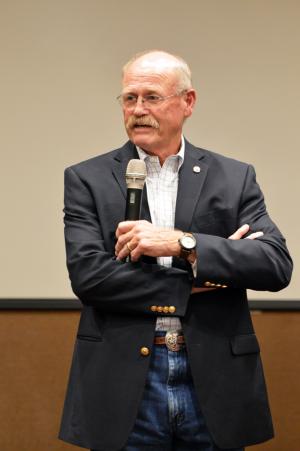Article & photo by Nancy Brannon, Ph.D.
Dr. Tom Lenz was the keynote speaker on Thursday evening, October 20, 2016 at the 2016 Certified Horsemanship Association International Conference. Dr. Lenz has been active for over 40 years in the world of equine veterinary health. He educates others about animal welfare, speaking to audiences in the equine, veterinary, and agriculture industries, as well as government groups. Dr. Lenz is a Past President of the American Association of Equine Practitioners (AAEP) and was honored with the 2005 AAEP Distinguished Service Award and the AAEP Lifetime Achievement Award in 2009. He is also a past chair of the AAEP’s Welfare Committee, and is currently on welfare committees for the American Horse Council, the Professional Rodeo Cowboy Association, the American Quarter Horse Association, the Missouri Veterinary Medical Association, and the American Veterinary Medical Association. He is the past chair of the Unwanted Horse Coalition and the current chair of the American Horse Council’s (AHC) Welfare Committee.
His presentation focused on the lessons learned in dealing with equine welfare issues and the Unwanted Horse situation. In the past, welfare issues were discussed and resolved within the horse community, but now animal welfare is a national issue where non-horse folks and animal activists, as well as state and local officials, are involved in the debate and legislative resolutions. Thus, how we communicate about and address equine welfare issues has changed.
Three main areas overlap in people’s perspectives about animal welfare: (1) Function: measures of health, growth, and productivity of animals; (2) Feelings: measures of affective states of animals (pain, suffering, contentment); (3) Natural Behavior: quantitative and qualitative comparisons to wild or free-living counterparts.
Animal related businesses may view animals as instruments for human use. Welfare and care for animals is important, but there are other considerations such as production efficiencies, costs, competitive pressures, and return on investment.
The public may have a different view of animal welfare, tempered by urbanization/suburbanization. Animals move from utility to companion. Pet owners are more like parents and are moderate animal rights advocates. Their vision of animal welfare is similar to their own, personal welfare.
Animal protection advocates have another viewpoint. They come from all walks of life with varying experiences. Many are not familiar with animal industries and animal care practices. But most are driven by a genuine desire to make sure animals are used appropriately.
Public officials also come from all walks of life and life experiences, too. Most are not familiar with animal use industries and animal care. But, in order to be re-elected/re-appointed, they often vote with the constituents’ loudest voices.
Ruth Harrison wrote a book on intensive farm practices in 1964 from which have been adapted “Five Freedoms,” which Lenz said should be called Five Needs. They are:
· Freedom from thirst, hunger, malnutrition
· Freedom from discomfort
· Freedom from pain, injury, disease
· Freedom to express normal behaviors
· Freedom from fear and distress (this one from J. Webster’s 2005 book Limping Towards Eden)
Lenz used raising chickens as his animal welfare example, and evaluated three types of chicken raising styles on these five criteria: caged, barn-kept, and free-range chickens. “Which option provides the best welfare for the chickens?” he asked. Many in the general public believe that free range chickens have the highest animal welfare and that chickens raised in cages have the lowest animal welfare because most folks evaluate chicken raising on one main criteria: whether or not they have freedom to express normal behaviors. The middle range alternative is barn-kept chickens, which rate the best on these five animal welfare criteria.
This evaluation shows that results might differ from expectations. There can be unintended consequences to animal welfare when we overemphasize a single criteria, such as behavioral concerns.
So, should all animal welfare decisions be science-based – on biological function, health, and normal behavior? The reality is that science can only determine what type and level or risks exist. It is society that determines what type or level of risk is acceptable. Science informs decisions, but people make them. We have to recognize that others’ experiences and expectations may not match our own. People’s emotions often take over and animal welfare comes to be viewed as a moral issue rather than a scientific issue. There is a social component to animal welfare and animal care that we need to recognize. Emotion and misinformation frequently triumph over science and fact just because of the way the information is presented. So it’s up to horse people to “be a focal point for equine welfare information,” Lenz said.
Lenz referred to a classic quote from Will Rogers: “Everybody is ignorant, only on different subjects.” While the public’s concern for horse welfare is at an all time high, the public’s knowledge of what constitutes good horse welfare is at a low.
“We need to be the educators to all about equine welfare,” Lenz told the audience. We have to continually work to improve the use and well-being of our horses. At the same time, we need to use critical thinking to evaluate why we do particular things and treat horses in particular ways. The excuse is that “we’ve always done it this way” doesn’t fly when there may be better ways available. We need to make changes – even hard changes – when they are indicated.
Dr. Tom Lenz was the keynote speaker on Thursday evening, October 20, 2016 at the 2016 Certified Horsemanship Association International Conference. Dr. Lenz has been active for over 40 years in the world of equine veterinary health. He educates others about animal welfare, speaking to audiences in the equine, veterinary, and agriculture industries, as well as government groups. Dr. Lenz is a Past President of the American Association of Equine Practitioners (AAEP) and was honored with the 2005 AAEP Distinguished Service Award and the AAEP Lifetime Achievement Award in 2009. He is also a past chair of the AAEP’s Welfare Committee, and is currently on welfare committees for the American Horse Council, the Professional Rodeo Cowboy Association, the American Quarter Horse Association, the Missouri Veterinary Medical Association, and the American Veterinary Medical Association. He is the past chair of the Unwanted Horse Coalition and the current chair of the American Horse Council’s (AHC) Welfare Committee.
His presentation focused on the lessons learned in dealing with equine welfare issues and the Unwanted Horse situation. In the past, welfare issues were discussed and resolved within the horse community, but now animal welfare is a national issue where non-horse folks and animal activists, as well as state and local officials, are involved in the debate and legislative resolutions. Thus, how we communicate about and address equine welfare issues has changed.
Three main areas overlap in people’s perspectives about animal welfare: (1) Function: measures of health, growth, and productivity of animals; (2) Feelings: measures of affective states of animals (pain, suffering, contentment); (3) Natural Behavior: quantitative and qualitative comparisons to wild or free-living counterparts.
Animal related businesses may view animals as instruments for human use. Welfare and care for animals is important, but there are other considerations such as production efficiencies, costs, competitive pressures, and return on investment.
The public may have a different view of animal welfare, tempered by urbanization/suburbanization. Animals move from utility to companion. Pet owners are more like parents and are moderate animal rights advocates. Their vision of animal welfare is similar to their own, personal welfare.
Animal protection advocates have another viewpoint. They come from all walks of life with varying experiences. Many are not familiar with animal industries and animal care practices. But most are driven by a genuine desire to make sure animals are used appropriately.
Public officials also come from all walks of life and life experiences, too. Most are not familiar with animal use industries and animal care. But, in order to be re-elected/re-appointed, they often vote with the constituents’ loudest voices.
Ruth Harrison wrote a book on intensive farm practices in 1964 from which have been adapted “Five Freedoms,” which Lenz said should be called Five Needs. They are:
· Freedom from thirst, hunger, malnutrition
· Freedom from discomfort
· Freedom from pain, injury, disease
· Freedom to express normal behaviors
· Freedom from fear and distress (this one from J. Webster’s 2005 book Limping Towards Eden)
Lenz used raising chickens as his animal welfare example, and evaluated three types of chicken raising styles on these five criteria: caged, barn-kept, and free-range chickens. “Which option provides the best welfare for the chickens?” he asked. Many in the general public believe that free range chickens have the highest animal welfare and that chickens raised in cages have the lowest animal welfare because most folks evaluate chicken raising on one main criteria: whether or not they have freedom to express normal behaviors. The middle range alternative is barn-kept chickens, which rate the best on these five animal welfare criteria.
This evaluation shows that results might differ from expectations. There can be unintended consequences to animal welfare when we overemphasize a single criteria, such as behavioral concerns.
So, should all animal welfare decisions be science-based – on biological function, health, and normal behavior? The reality is that science can only determine what type and level or risks exist. It is society that determines what type or level of risk is acceptable. Science informs decisions, but people make them. We have to recognize that others’ experiences and expectations may not match our own. People’s emotions often take over and animal welfare comes to be viewed as a moral issue rather than a scientific issue. There is a social component to animal welfare and animal care that we need to recognize. Emotion and misinformation frequently triumph over science and fact just because of the way the information is presented. So it’s up to horse people to “be a focal point for equine welfare information,” Lenz said.
Lenz referred to a classic quote from Will Rogers: “Everybody is ignorant, only on different subjects.” While the public’s concern for horse welfare is at an all time high, the public’s knowledge of what constitutes good horse welfare is at a low.
“We need to be the educators to all about equine welfare,” Lenz told the audience. We have to continually work to improve the use and well-being of our horses. At the same time, we need to use critical thinking to evaluate why we do particular things and treat horses in particular ways. The excuse is that “we’ve always done it this way” doesn’t fly when there may be better ways available. We need to make changes – even hard changes – when they are indicated.









